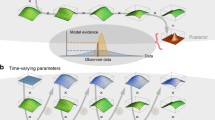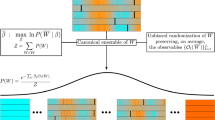Summary
In this article we present a solution to the problem of constructing a statistical decision theory for discrete stochastic processes. In doing this we also develop a theoretical frame-work for combining cross-section and time-series analyses of non-stationary random processes. Our general approach is similar to that used by Blackwell and Girschick in their book,Theory of Games and Statistical Decisions [4]. More specifically, the statistician is always pictured as a gambler playing a game against nature, and the strategies of nature are identified with the unknown statistical parameters in the relevant problem.
In section 2 we discuss briefly our approach to the solution of the problems suggested above. First we justify our characterization of the strategies of nature in light of well-known results in the theory of stochastic processes. We then point out major difficulties that inevitably arise when an attempt is made to apply generally known decision theoretic results to time series analysis. Next we develop several ergodic theorems which show how these inherent difficulties can be avoided in the analysis of time series generated by “dynamic stochastic processes” if cross-section analysis is used to provide certain necessarya priori information. Finally we define and specify our assumptions concerning the statistician's space of randomized strategies and his loss function.
In section 3 we present our major statistical results. We first give a new elementary proof of a generally known theorem in decision theory and develop several simple applications of this theorem to tests of hypotheses and to prediction in time-series analysis. Next we state and prove several general theorems concerning the possibility of using cross-section data asa priori information in time series analysis. These results suggest a new and theoretically sound approach for providing the statistician, who studies non-stationary time series, with strategies that are, not only “good” in a decision theoretic sense, but also possess certain required asymptotic properties.
In section 4 we illustrate the usefulness of results obtained in section 3 by using them to solve a problem in inventory management. More specifically, we show that if the probability distribution determining demand for a particular product is known, an inventory manager who stocks the product has an optimal ordering policy in each period. Moreover, we show that if the manager follows this optimal policy, his behavior over time can be represented by a stochastic process in one and only one way. Finally, in the case when “nature” has more than one strategy, we provide conditions on the strategies of nature sufficient to ensure that the manager has a “good” pure strategy. The results of section 4 generalize well-known results on inventory management due to Bellman [3], to Dvoretzky, Kiefer, and Wolfowitz [6], and to Karlin [1].
Before continuing we would like to express our gratitude to Professors H. P. McKean and H. Furstenberg for pointing out several flaws in our reasoning in an earlier draft; and to Professors J. C. Kiefer and R. Farrell for helpful comments and criticism. Thanks are also due to Professors H. S. Houthakker and H. Raiffa for help and encouragement. Needless to say any remaining errors are the author's responsibility alone.
Similar content being viewed by others
References
K. J. Arrow, S. Karlin and H. Scarf,Studies in the Mathematical Theory of Inventory and Production, Stanford University Press, Stanford, California, 1958.
S. Banach,Théorie des Opérations Linéaires, Warszawa, 1932.
R. Bellman,Dynamic Programming, Princeton University Press, Princeton, N.J., 1957.
D. Blackwell and M. A. Girschick,Theory of Games and Statistical Decisions, John Wiley and Sons, Inc., New York, 1954.
J. L. Doob,Stochastic Processes, John Wiley and Sons, Inc., New York, 1959.
A. Dvoretzky, J. Kiefer and J. Wolfowitz, “The inventory problem: I, Cases of known distribution of demand; II, Case of unknown distribution of demand,”Econometrica, 20, 2–3 (1953).
R. H. Farrell, “Weak limits of sequences of Bayes procedures in estimation theory”, Unpublished paper, Feb. 1965.
H. Furstenberg,Stationary Processes and Prediction Theory, Princeton University Press, Princeton, N.J., 1960.
S. Kakutani, “Concrete representations of (M) spaces,”Ann. Math., 42 (2), 1941.
S. Karlin, “Operator treatment of minimax principle,”Annals of Mathematics Studies, 24, 1950.
Le Cam, Unpublished manuscript on statistical decision theory, 1965.
E. L. Lehmann,Testing Statistical Hypotheses, John Wiley and Sons, Inc., New York, 1959.
M. Loève,Probability Theory, D. Van Norstrand Company, Inc., Princeton, N.J., 1960.
B. P. Stigum, “Dynamic stochastic processes,”Ann. Math. Statist., 34 (1963), 274–283.
P. Whittle,Hypothesis Testing in Time Series Analysis, Almquist and Wicksell, Upsala, 1951.
H. Wold,A Study in the Analysis of Stationary Time Series, Almquist and Wicksell, Stokholm, 1954.
Author information
Authors and Affiliations
Additional information
Financial support of this research from the National Science Foundation is gratefully acknowledged.
About this article
Cite this article
Stigum, B.P. A decision theoretic approach to time series analysis. Ann Inst Stat Math 19, 207–243 (1967). https://doi.org/10.1007/BF02911677
Received:
Issue Date:
DOI: https://doi.org/10.1007/BF02911677




